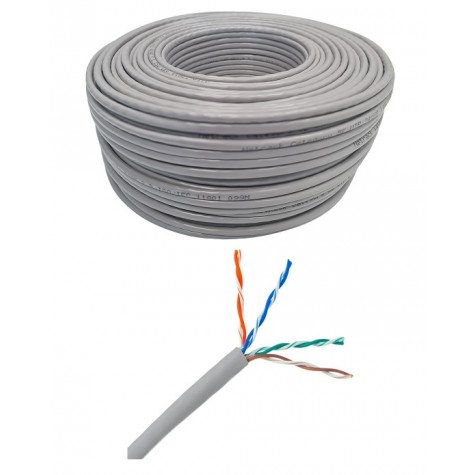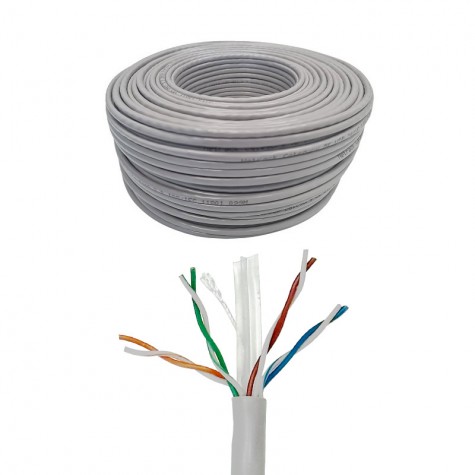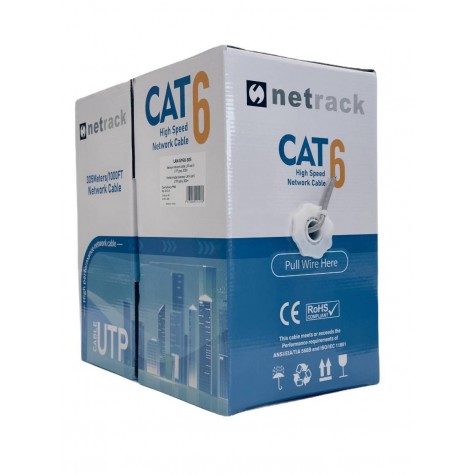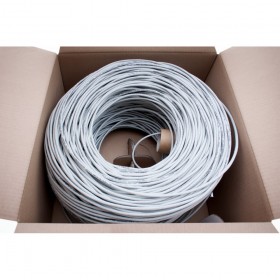Filter By
LAN cables
-
LAN network cable cat. 5e UTP, gray, 100m, CCA
PLN49.00BiTLAN U/UTP cat. 5e are designed to work in computer networks in which the frequency band up to 200 MHz is used. The cables are suitable for the transmission of data, sound and television images with a binary bandwidth of up to 1 Gb/s. They are used for permanent installation in the so-called structured cabling inside buildings in accordance with the PN-EN 50173-1, ISO/IEC 11801, ANSI/TIA 568-C.2 standards, as well as for use in industrial networks not exposed to external electromagnetic interference. Cables classified according to PN-EN 50575 (CPR).
-
LAN network cable cat. 5e UTP, gray, 305m, CCA
PLN149.00BiTLAN U/UTP cat. 5e are designed to work in computer networks in which the frequency band up to 200 MHz is used. The cables are suitable for the transmission of data, sound and television images with a binary bandwidth of up to 1 Gb/s. They are used for permanent installation in the so-called structured cabling inside buildings in accordance with the PN-EN 50173-1, ISO/IEC 11801, ANSI/TIA 568-C.2 standards, as well as for use in industrial networks not exposed to external electromagnetic interference. Cables classified according to PN-EN 50575 (CPR).
-
LAN network cable cat. 5e UTP, gray, 50m, CCA
PLN31.90BiTLAN U/UTP cat. 5e are designed to work in computer networks in which the frequency band up to 200 MHz is used. The cables are suitable for the transmission of data, sound and television images with a binary bandwidth of up to 1 Gb/s. They are used for permanent installation in the so-called structured cabling inside buildings in accordance with the PN-EN 50173-1, ISO/IEC 11801, ANSI/TIA 568-C.2 standards, as well as for use in industrial networks not exposed to external electromagnetic interference. Cables classified according to PN-EN 50575 (CPR).
-
LAN network cable cat. 6 UTP, gray, 100m, CCA
PLN69.00BiTLAN U/UTP cat. 5e are designed to work in computer networks in which the frequency band up to 200 MHz is used. The cables are suitable for the transmission of data, sound and television images with a binary bandwidth of up to 1 Gb/s. They are used for permanent installation in the so-called structured cabling inside buildings in accordance with the PN-EN 50173-1, ISO/IEC 11801, ANSI/TIA 568-C.2 standards, as well as for use in industrial networks not exposed to external electromagnetic interference. Cables classified according to PN-EN 50575 (CPR).
-
Twisted pair U/UTP cat. 5e 100% copper 305m - BITNER , BiTLAN, 200 MHz
PLN699.99BiTLAN U/UTP cat. 5e are designed to work in computer networks in which the frequency band up to 200 MHz is used. The cables are suitable for the transmission of data, sound and television images with a binary bandwidth of up to 1 Gb/s. They are used for permanent installation in the so-called structured cabling inside buildings in accordance with the PN-EN 50173-1, ISO/IEC 11801, ANSI/TIA 568-C.2 standards, as well as for use in industrial networks not exposed to external electromagnetic interference. Cables classified according to PN-EN 50575 (CPR).
Network cables , commonly also referred to as twisted pair , are signal cables used to transmit information. It is the basic element of the structural network. Most often, a network cable is equipped with 4 pairs of single wires such as wire or cord (e.g. patchcords ) . The common name is directly related to the structure of the conduit. In order to better transmit and reduce the interference between the pairs (crosstalk), a special arrangement of the wires was used. In each pair, the wires are twisted with each other at a specific frequency. Additionally, all 4 pairs are also twisted. This significantly reduces the interference caused by electromagnetic fields and improves the transmission parameters.
Which ethernet cable should you choose?
Depending on the type of shielding, there are many types of cables. The screen used is specified by the abbreviations used:
- U, unshielded - unshielded
- F, ang. folied - foil shielded
- S, ang, shielded - mesh shielded
- SF - screened with mesh and foil
Taking into account the construction of the cable, the place and the method of screening, more detailed markings are used:
- U / UTP - unshielded twisted pair, formerly called UTP
- F / UTP - twisted pair shielded with foil, formerly called FTP
- S / UTP - twisted pair shielded with mesh
- SF / UTP - twisted pair shielded with mesh and foil, formerly called STP
- U / FTP - twisted pair with each pair shielded separately with foil
- F / FTP - twisted pair with each pair shielded separately with foil and additionally the entire cable additionally shielded with foil
- S / FTP - twisted pair with each pair shielded separately with foil and additionally the entire cable additionally shielded with mesh, formerly called SFTP
- SF / FTP - twisted pair with each pair shielded separately with foil and additionally the entire cable additionally shielded with mesh and foil
Securing networks with lan cables from Netrack
Remember that in order to take full advantage of the advantages of shielded cables , you must ensure that the protection is continuous. Therefore, all elements of a computer network should be shielded. This includes sockets , patch panels , patchcords. The best effect is obtained when active devices, computers, etc. are connected to a grounded network. The cabinet and all its elements are earthed. Shielded internet cables should be connected to shielded components and unshielded to unshielded. In the latter case, the use of screen components is possible and will not lower the network parameters.
Wires, just like other network elements, can be divided into categories:
- D - category 5e
- E - category 6
- EA - Category 6A
- F - category 7
- FA - category 7A
Network cable - what does its transmission speed depend on
The higher network cable category , the higher the transmission speed can be obtained. It should be remembered, however, that the speeds are equally dependent on the parameters of the structural network and the active devices used. With the same network parameters (classes or categories), better transmission parameters can be obtained by using more technologically advanced devices.
Why isn't it worth saving money on LAN cables?
It should be emphasized that LAN cable is the basic element of a structural network. Besides, it is difficult to repair, modernize or replace. Cables are led to virtually all places in buildings, often in narrow conduits, often inside walls. Replacing or laying a new cable is very inconvenient for the users of the facility and is expensive. Therefore, when designing structural networks, pay special attention to LAN cables and conduct installation in accordance with the rules and standards.
Comparision table LAN cables
| Image | Product name | Price (PLN) |
|---|---|---|

|
LAN network cable cat. 5e UTP, gray, 100m, CCA | 49.00 |

|
LAN network cable cat. 6 UTP, gray, 100m, CCA | 69.00 |

|
LAN network cable cat. 5e UTP, gray, 50m, CCA | 31.90 |

|
LAN network cable cat. 5e UTP, gray, 305m, CCA | 149.00 |

|
Kabel sieciowy LAN kat. 6 UTP, 50m, CCA, , szary | 35.90 |

|
Kabel sieciowy LAN kat. 6 UTP, 305m, CCA, , szary | 189.00 |












